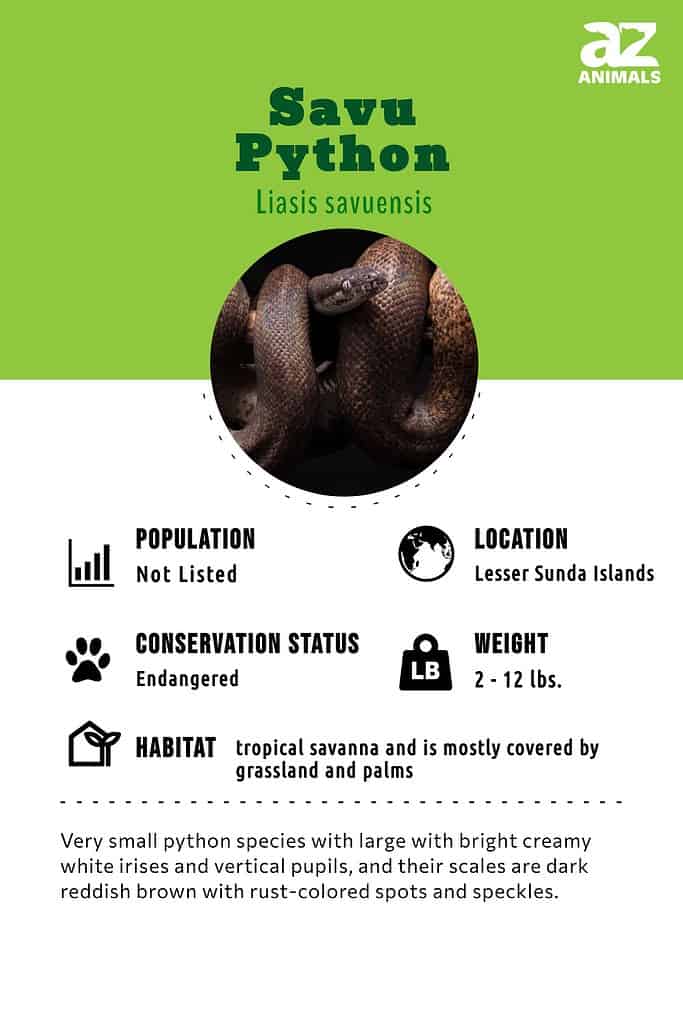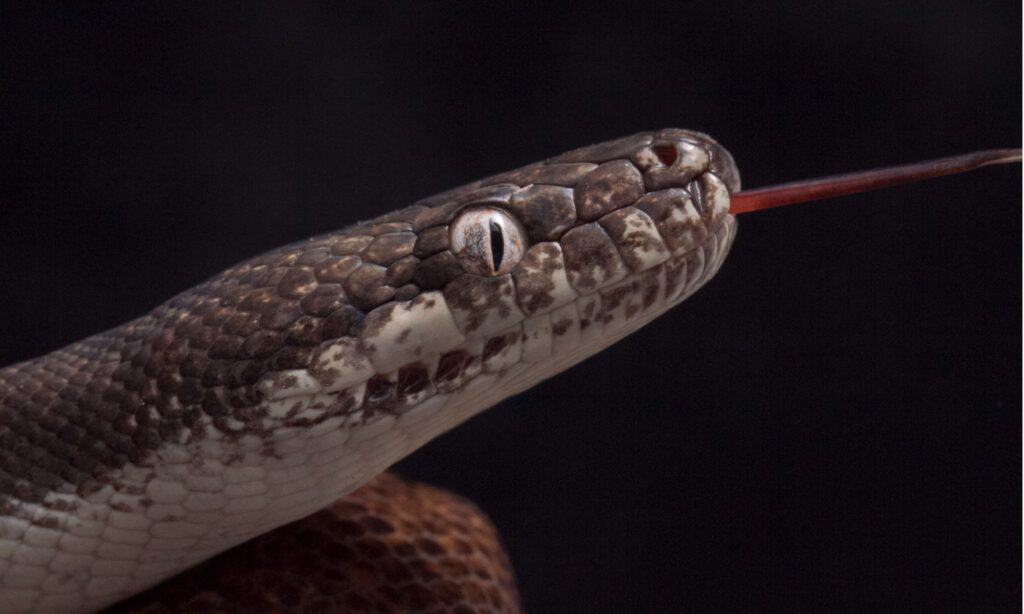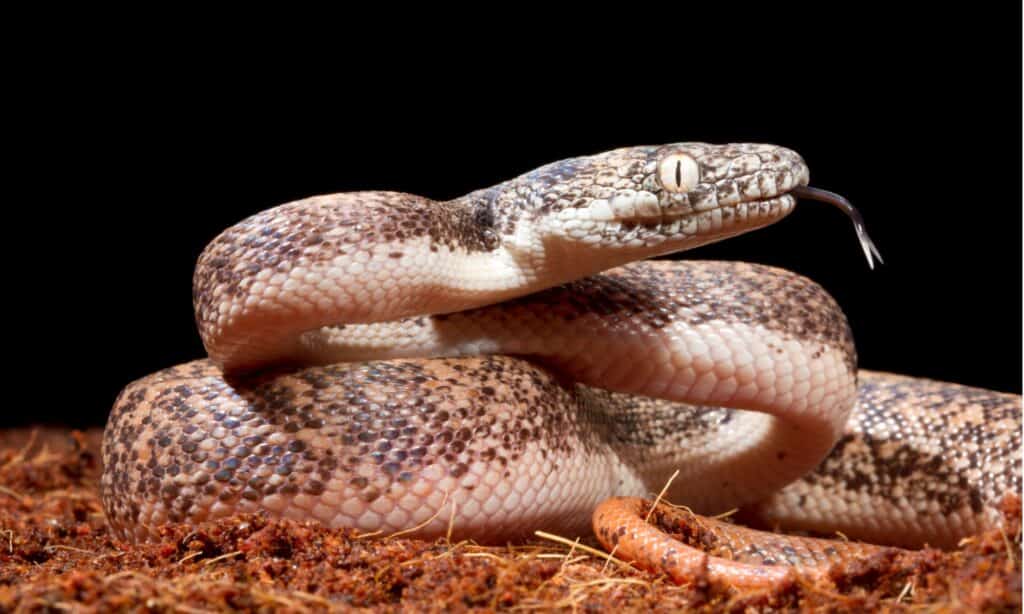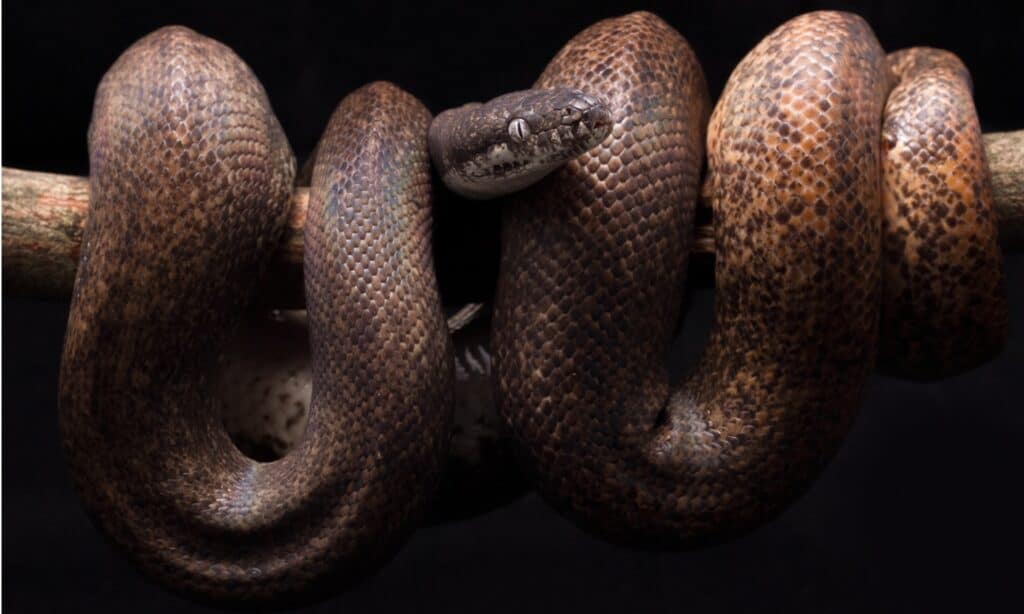Savu Python
Liasis savuensis
Before ball pythons' morphs became popular, Savu pythons were everywhere in the pet trade.
Advertisement
Savu Python Scientific Classification
- Kingdom
- Animalia
- Phylum
- Chordata
- Class
- Reptilia
- Order
- Squamata
- Family
- Pythonidae
- Genus
- Liasis
- Scientific Name
- Liasis savuensis
Read our Complete Guide to Classification of Animals.
Savu Python Conservation Status
Savu Python Facts
- Prey
- Rodents, ground-nesting birds
- Name Of Young
- Hatchlings, neonates
- Group Behavior
- Solitary except during mating season
- Fun Fact
- Before ball pythons' morphs became popular, Savu pythons were everywhere in the pet trade.
- Biggest Threat
- Over-harvesting for the pet trade.
- Most Distinctive Feature
- Bright white eyes
- Distinctive Feature
- Iridescent scales and beautiful speckling.
- Other Name(s)
- Freckled python, white-eyed python, and by locals as sanca mata putih.
- Age Of Independence
- Hatching
- Diet for this Fish
- Omnivore
- Lifestyle
- Crepuscular
- Common Name
- White-eyed python
- Number Of Species
- 1
- Location
- Savu island
- Average Clutch Size
- 3
Savu Python Physical Characteristics
- Color
- Brown
- Grey
- Red
- Dark Brown
- Orange
- Light Grey
- Skin Type
- Scales
- Lifespan
- 20+ years in captivity
- Length
- 3.5-4.5 feet long
- Age of Sexual Maturity
- About 3 years
- Venomous
- No
- Aggression
- Low
View all of the Savu Python images!
The Savu python is one of the smallest pythons in the world and lives on a 60-square-mile island.
If this petit snake’s distinctive eye color doesn’t catch your attention, its size and ease of handling will. This species was first imported into the United States in the mid-1990s and, since then, has become popular with snake owners.
Incredible Savu Python Facts
- Savu pythons have bright white eyes, leading to one of their common names, the white-eyed python.
- These snakes are small and only reach 3.5-4.5 feet long.
- They only live on one of the Lesser Sunda Islands, which are off the north coast of Australia.
- Savu pythons change color as they age, sometimes darkening to the point of being black.

Scientific Name and Classification
Savu pythons are members of the Pythonidae family. They’re nonvenomous constrictors that are cousins to the olive python (L. olivaceous), a much larger python native to northern Australia.
They were first described in 1956 as a subspecies of Macklot’s python (Liasis mackloti). In 2004, researchers presented genetic evidence to support the idea that the Savu python isn’t a subspecies but, instead, a species. There is still a bit of disagreement on this, and some still refer to it as a subspecies. However, most sources classify it as a species in its own right: Liasis savuensis. The genus name may be related to the word lias, which is a type of blue limestone. The specific name, savuensis, references the island to which they’re native. They have a few common names, including freckled python, white-eyed python, and by locals as sanca mata putih.

The savu python’s eyes give rise to another of its names: the white-eyed python.
©iStock.com/dwi septiyana
Appearance
This snake is one of the smallest python species in the world. While a few rare individuals may reach five feet long, the Savu python usually ranges between 3.5 and 4.5 feet long. It is slender and has highly iridescent, smooth, and shiny scales down the length of its body. The scales on the snake’s head are large and somewhat shield-shaped, diminishing into smaller scales as you approach the neck.
When they hatch, these snakes range from bright reddish brown to orange; as they mature, their bodies change dramatically to a dark reddish brown with rust-colored spots and speckles. Their bellies and under their chins are cream-colored and sometimes have freckles or spots but are mostly clear. You’ll sometimes see a nearly black Savu python or one that retained some of its reds as an adult.
However, their most distinctive feature is their eyes, which is where they get one of their names – the white-eyed python. They are large with bright creamy white irises and vertical pupils.

Pythons, like this young White-eyed python, pull their heads into an S shape when they feel threatened.
©iStock.com/David Kenny
Behavior
This python is newer to science, so there’s a lot we don’t yet know. Savu pythons are relatively docile and aren’t inclined to bite. Some sources say that they can be cranky, but those may be referring to Macklot’s python, which can be cranky and gets quite a bit bigger. These snakes are active foragers and are often found cruising through rock crevices and in the underbrush looking for food.
These snakes are crepuscular, meaning they’re most active during dawn and dusk. They are terrestrial and somewhat fossorial; they do not spend much time in the trees. Even though most of the primary forests have been converted to agricultural use, Savu pythons seem to have adapted fairly well.
History and Evolution
Pythons’ ancestors, just like other snakes, were actually legged reptiles, similar to lizards and reptiles that spent more time in and near water. At some point, they either lost their legs or became vestigial, as they became more and more unused. It is fascinating to know that some species evolved to have legs and then evolved to lose them! For whatever reason, snakes found a way to survive and thrive because they were lower to the ground.
Pythons were previously classified with boas, but modern research has shown that the pythons and boas are separate species due to convergent evolution in different parts of the world, much like monkeys evolved differently in Africa and South America while having shared ancestors. Some of the major differences are that boas give birth to live young, and pythons lay eggs. Pythons also have their heat-sensing pits on their labial scales, and boas have them in between their labial scales.
The Savu Pythons are much smaller than some of the other types of pythons. Historically, it must have been more and more advantageous as a breed for them to be smaller. Smaller offspring became more adept at hunting and surviving on Savu, which is why this particular snake has the look and size that it does today.

As Savu pythons mature, they go through an ontogenic change from the brilliant reds and oranges of youth to the darker red-brown you see here.
©iStock.com/dwi septiyana
Habitat and Diet
These pythons are only found on Savu, an island that spans about 60 square miles, in the Lesser Sunda Islands. It’s possible that they’re also on Raijua, which is only a couple of miles from Savu, but no one has confirmed this. These snakes don’t specialize in any one part of the island; they seem to be generalists and inhabit all areas of the island.
Savu pythons are tolerant of a fairly wide range of humidity and temperature. The hot, dry winds that blow in from Australia really suck the humidity out of the air. Yet, these snakes can take it.
Savu is a tropical savanna and is mostly covered by grassland and palms. It has months of dry weather every year because of the dry winds from Australia. The rest of the island is farmland and rock outcrops that display Savu’s volcanic past. The python inhabits all of these areas, but it seems to prefer areas near freshwater, including rice fields. They’re also fond of rocky areas and can be found foraging in those crevices for prey. Savu pythons eat various small animals like rodents and birds.
Predators, Threats, Conservation, and Population
The main predators of Savu pythons are birds of prey and possibly carnivorous mammals.
Savu pythons are listed as endangered on the IUCN Redlist of Threatened Species. They only occur on one of the Lesser Sunda Islands and, as such, are vulnerable to extinction in the wild. The number of adult individuals appears to be decreasing, and the species is already rare. De Lang in 2011 recommended further research into the population of the species and its ecology.
With a natural range that’s so small, it’s easy to see how this snake could become endangered or even extinct in the wild. Savu pythons are listed under CITES Appendix II, but the demand for these snakes in the pet trade is ever-increasing. Also of note is that the CITES database doesn’t differentiate between Savu pythons (L. savuensis) and Macklot’s python (L. mackloti). As a result, we really don’t know how many individuals of this species were taken, and it continues to be heavily harvested for export.
These snakes were once more readily available from breeders, but ball pythons and all their color morphs took off in popularity. However, Savu pythons are becoming popular again, so we’ll probably see more captive-bred individuals on the market for sale.
Reproduction, Babies, and Lifespan
In the wild, Savu pythons probably breed in June-July. Several weeks after mating, the females lay clutches of 3-8 eggs which must incubate for about 60-70 days. Like other pythons, females coil around their eggs until they hatch. They’re easy to breed in captivity and make great pet snakes.
When they hatch, babies are ready to take care of themselves, and after their first shed cycle, they’ll head out from their hatching spot on their own. In captivity, they can live over 20 years; in the wild, that number is probably closer to 10-15 years.
View all 292 animals that start with SSavu Python FAQs (Frequently Asked Questions)
What do Savu pythons eat?
This terrestrial species eats rodents, frogs, lizards, and sometimes ground-nesting birds.
How do Savu pythons hunt?
Like other snakes, they’re ambush predators. So they are likely to find a nice hiding place to coil up and wait for their food. However, they are fairly active and are likely to forage as well.
Where do Savu pythons live?
Only on the island of Savu. They may be on Raijua, but that’s not been confirmed.
Are Savu pythons aggressive?
They can be a little snippy when you take them out of their enclosure, but they settle down quickly.
Are Savu pythons good pets?
Actually, yes, there were more available from breeders before ball pythons and all their morphs became popular.
Thank you for reading! Have some feedback for us? Contact the AZ Animals editorial team.
Sources
- Savu Python | IUCN Redlist of Threatened Species / Published August 6, 2019 / Accessed July 26, 2022
- Liasis mackloti | Reptile database / Accessed July 28, 2022
- (1970)















